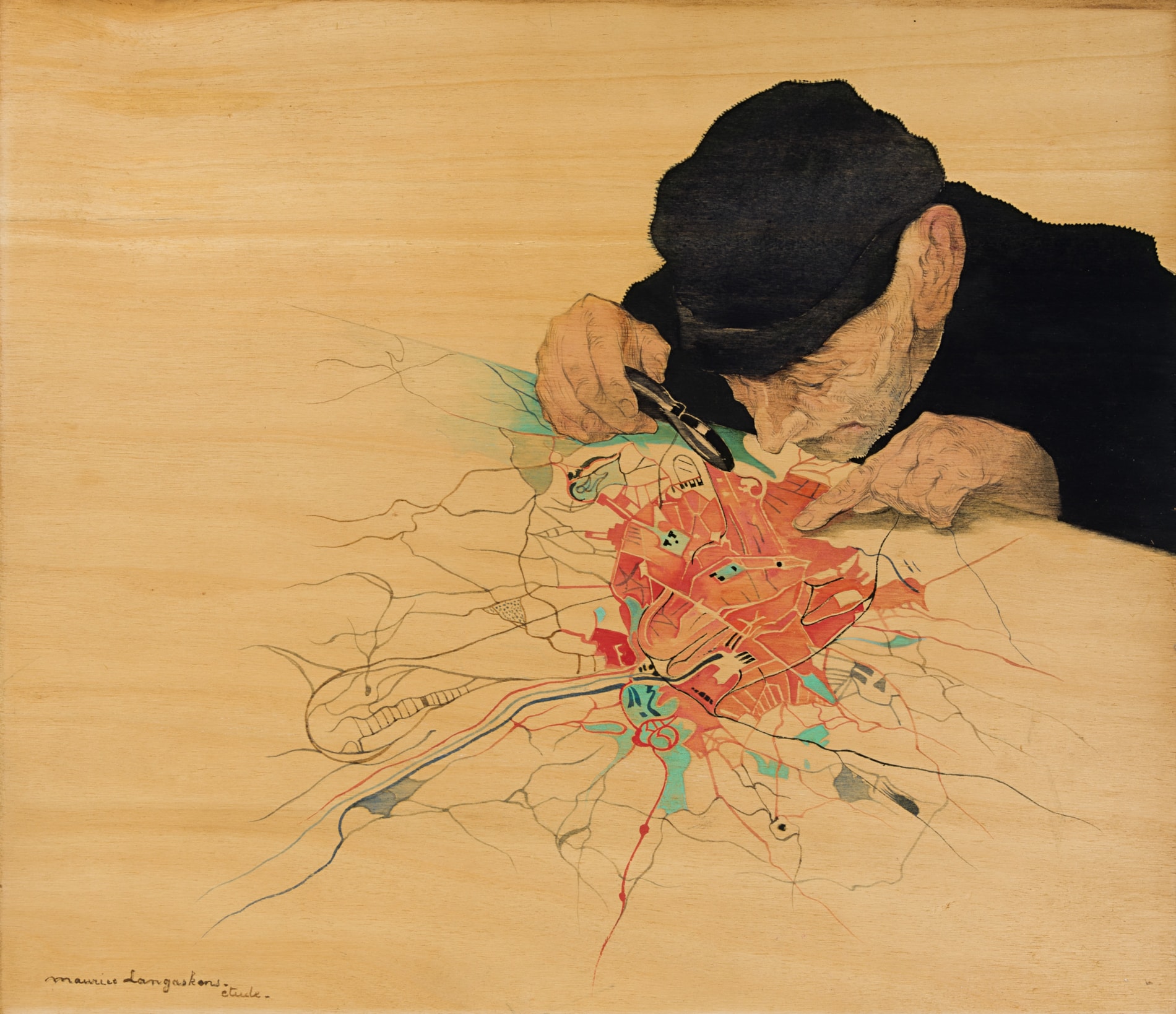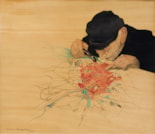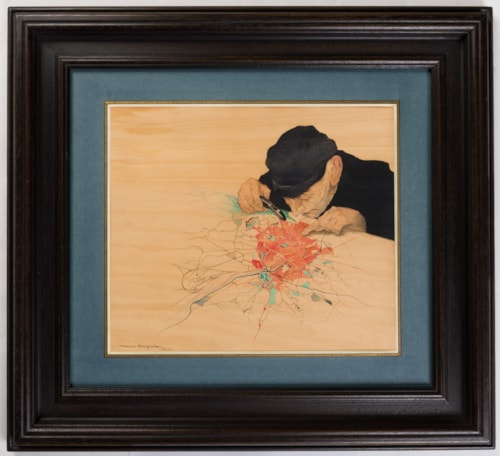Maurice LANGASKENS
(Ghent 1884 - Schaerbeek 1946)
An Elderly Man Studying a Map (Le géographe)
Sold
Pencil and black ink and watercolour on panel.
Signed and inscribed Maurice Langaskens. / étude. at the lower left.
300 x 345 mm. (11 7/8 x 13 5/8 in.)
Signed and inscribed Maurice Langaskens. / étude. at the lower left.
300 x 345 mm. (11 7/8 x 13 5/8 in.)
Although Maurice Langaskens rarely dated his work, this sketch on panel can be dated to around 1930. Drawn with pen and black ink and watercolour on a plywood panel, it is a study for a colour aquatint by Langaskens entitled Le Géographe. In both the drawing and the related print, the man appears to be examining a map of the city of Brussels. The artist created a number of drawn and etched variants of this subject, with an elderly man intensely studying a map, an atlas or a globe.
An analogous subject is also found in a small panel of an entomologist scrutinizing an insect - of similar dimensions, medium and technique to the present panel - which appeared at auction in Paris in 2008.
An analogous subject is also found in a small panel of an entomologist scrutinizing an insect - of similar dimensions, medium and technique to the present panel - which appeared at auction in Paris in 2008.
A Belgian painter and printmaker, Maurice (Maurits) Langaskens enrolled in the Académie Royale des Beaux-Arts in Brussels in 1901, and was trained as a decorative painter by the leading Belgian muralist and sculptor Constant Montald. From early on Langaskens was recognized as a fine draughtsman, and won several prizes at the Académie. After living and studying for a few months in France in 1906, mainly in Dijon, the young Langaskens settled in Schaerbeek, outside Brussels. He began his independent career in 1907, when he exhibited three decorative paintings at the Salon in Brussels for the first time and also had an exhibition of his work shown at the Salle Boute in the city. The following year he contributed six paintings to the 16th annual exhibition of the Belgian artist’s association ‘Pour l’Art’ in Brussels, where he was to exhibit frequently over the course of his later career, until 1941. (Langaskens also designed the poster for the 17th ‘Pour l’Art’ exhibition in 1909.) Also in 1908, one of his paintings was selected for an exhibition of modern Belgian art in Berlin.
Much of Langaskens’s early work was in a vibrant and visually arresting Art Nouveau or Symbolist style. This bold and colourful manner also translated well into large-scale mural commissions, and he soon became one of the leading painter-decorators of the early 20th century in Belgium. His decoration of the town hall of the city of Zoutleeuw in 1912 earned the artist considerable fame and the praise of his teacher and mentor Montald: ‘He was one of the best students in the class; today he is the most outstanding artist among the decorators of our time.’ The same year the first of several exhibitions of Langasken’s work was mounted at the Cercle Artistique et Littéraire in Brussels.
The outbreak of the First World War, however, brutally interrupted the rise of the artist’s successful career. Drafted into the Belgian army at the beginning of August 1914, Langaskens was captured by the Germans after less than a fortnight. He spent the next three and half years as a prisoner of war, at internment camps at Sennelager, Münsterlager and Göttingen. He produced numerous, mostly small-scale paintings and watercolours of portraits and depictions of many of his fellow prisoners, as well as scenes of daily camp life, that are today regarded as among his finest and most personal works. It was also during this period that he painted two of his best-known pictures, the large canvas In Memoriam, painted in 1916 and depicting the burial of a Belgian soldier by his comrades, and the monumental triptych Repose en Paix, painted between 1915 and 1918. After his liberation and return to Belgium, Langaskens exhibited over eighty of the paintings and drawings that he had produced as a prisoner of war at the Galerie Sneyers in Brussels in 1918.
After the Armistice, Langaskens - suffering from aphasia and nervous disorders brought about by his long confinement - painted mainly easel pictures of winter landscapes, rustic genre scenes and floral subjects, and also produced a number of designs for tapestries, book illustrations and stained-glass windows. Within a few years, however, his health had recovered and he returned to undertaking large-scale decorative mural commissions. In 1920 Langaskens was one of the founders, alongside Montald, Jean Delville, Emile Fabry and Albert Ciamberlani, of the Société de l’art Monumental, dedicated to the monumental decoration of public buildings and their integration into architecture. Among his first public commissions after the war was a large mural decoration for a school in Schaarbeek, completed in 1922. A monograph devoted to Langaskens was published in 1923, and important exhibitions of his paintings, drawings and prints were held in galleries in Brussels in 1924, 1925, 1930 and 1936.
Between 1934 and 1935 Langaskens, along with other members of the Société de l’art Monumental, contributed to the extensive decoration of the municipal theatre at Leuven. He continued to exhibit throughout the 1940s, particularly at the yearly ‘Pour l’Art’ exhibitions. There he showed more and more of his superb graphic work, which had begun to take up much of his time. In 1943 Langaskens also provided illustrations for an edition of Maxence Van der Meersch’s novel L’empreinte du Dieu. After the artist’s death in 1946, the contents of his studio were sold at auction in Brussels and subsequently dispersed. Memorial exhibitions were held in Brussels in 1949 and in Schaarbeek in 1956, while more recently a retrospective exhibition of his work was mounted at the In Flanders Fields Museum in Ypres in 2003.
By far the largest and most comprehensive collection of works on paper by Maurice Langaskens – numbering over five hundred drawings, watercolours and prints, mainly dating from his time as a prisoner of war but also including works from throughout his career - is today in the In Flanders Fields Museum in Ypres. Other drawings by the artist are in the Royal Museum of the Armed Forces and Military History in Brussels, the Metropolitan Museum of Art in New York, the Historial de la Grande Guerre in Péronne, the Commune de Schaerbeek, and in several private collections.
Much of Langaskens’s early work was in a vibrant and visually arresting Art Nouveau or Symbolist style. This bold and colourful manner also translated well into large-scale mural commissions, and he soon became one of the leading painter-decorators of the early 20th century in Belgium. His decoration of the town hall of the city of Zoutleeuw in 1912 earned the artist considerable fame and the praise of his teacher and mentor Montald: ‘He was one of the best students in the class; today he is the most outstanding artist among the decorators of our time.’ The same year the first of several exhibitions of Langasken’s work was mounted at the Cercle Artistique et Littéraire in Brussels.
The outbreak of the First World War, however, brutally interrupted the rise of the artist’s successful career. Drafted into the Belgian army at the beginning of August 1914, Langaskens was captured by the Germans after less than a fortnight. He spent the next three and half years as a prisoner of war, at internment camps at Sennelager, Münsterlager and Göttingen. He produced numerous, mostly small-scale paintings and watercolours of portraits and depictions of many of his fellow prisoners, as well as scenes of daily camp life, that are today regarded as among his finest and most personal works. It was also during this period that he painted two of his best-known pictures, the large canvas In Memoriam, painted in 1916 and depicting the burial of a Belgian soldier by his comrades, and the monumental triptych Repose en Paix, painted between 1915 and 1918. After his liberation and return to Belgium, Langaskens exhibited over eighty of the paintings and drawings that he had produced as a prisoner of war at the Galerie Sneyers in Brussels in 1918.
After the Armistice, Langaskens - suffering from aphasia and nervous disorders brought about by his long confinement - painted mainly easel pictures of winter landscapes, rustic genre scenes and floral subjects, and also produced a number of designs for tapestries, book illustrations and stained-glass windows. Within a few years, however, his health had recovered and he returned to undertaking large-scale decorative mural commissions. In 1920 Langaskens was one of the founders, alongside Montald, Jean Delville, Emile Fabry and Albert Ciamberlani, of the Société de l’art Monumental, dedicated to the monumental decoration of public buildings and their integration into architecture. Among his first public commissions after the war was a large mural decoration for a school in Schaarbeek, completed in 1922. A monograph devoted to Langaskens was published in 1923, and important exhibitions of his paintings, drawings and prints were held in galleries in Brussels in 1924, 1925, 1930 and 1936.
Between 1934 and 1935 Langaskens, along with other members of the Société de l’art Monumental, contributed to the extensive decoration of the municipal theatre at Leuven. He continued to exhibit throughout the 1940s, particularly at the yearly ‘Pour l’Art’ exhibitions. There he showed more and more of his superb graphic work, which had begun to take up much of his time. In 1943 Langaskens also provided illustrations for an edition of Maxence Van der Meersch’s novel L’empreinte du Dieu. After the artist’s death in 1946, the contents of his studio were sold at auction in Brussels and subsequently dispersed. Memorial exhibitions were held in Brussels in 1949 and in Schaarbeek in 1956, while more recently a retrospective exhibition of his work was mounted at the In Flanders Fields Museum in Ypres in 2003.
By far the largest and most comprehensive collection of works on paper by Maurice Langaskens – numbering over five hundred drawings, watercolours and prints, mainly dating from his time as a prisoner of war but also including works from throughout his career - is today in the In Flanders Fields Museum in Ypres. Other drawings by the artist are in the Royal Museum of the Armed Forces and Military History in Brussels, the Metropolitan Museum of Art in New York, the Historial de la Grande Guerre in Péronne, the Commune de Schaerbeek, and in several private collections.
Provenance
Anonymous sale, Brussels, Hôtel de Ventes Horta, 20 January 2014, lot 242
Day and Faber, London
Agnew’s, London.
Day and Faber, London
Agnew’s, London.






